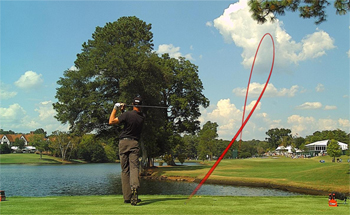Networks Tee UpNew Golf Swings

The idea behind golf seems deceptively simple—hit a small ball down a fairway into a hole—but the reality always proves to be anything but. And television coverage of major golf tournaments is even more complex and technically challenging than the hazards faced by professional golfers trying to navigate the deep bunkers and blazingly fast greens of a top-rated course.
“A big tournament is like the Super Bowl spread out over four days,” says Dan Overleese, VP of operations at Golf Channel.
That’s because major 18-hole productions often require the mobilization of resources rarely seen outside an Olympics or Super Bowl. At this month’s U.S. Open, NBCUniversal sent about 350 people from NBC, 150 from Golf Channel, 50 from Comcast SportsNet Philadelphia and 10 from its NBC10 station in Philly.
For the live production, NBC had more than 60 cameras, with multiple cameras on each hole, and around 12 mobile units from NEP and CP Communications; Golf Channel had 16 cameras and two sets for its pre- and post-event coverage.
Always Start With Fiber
To handle all that footage, NBC laid around 520 miles of fiber cable. Parent company Comcast ran another 112 miles of !ber to help tie together all the operations and cameras, which extensively shared content and resources.
“It is a merger of all our efforts into one footprint where we can feed off of each other,” says Ken Goss, senior VP of remote operations and production planning at NBC Sports/NBC Sports Network and Golf Channel.
Much of this complexity reflects the nature of the sport. Unlike football stadiums that are designed for TV coverage of a three-hour contest and are regularly visited by crews throughout the year, golf production teams must set up operations on courses they may not have encountered for several years. They also need to capture a wide panorama of action spread out over multiple days and 18 holes.
“You may have 70 [players] hitting the ball at any one time,” notes Ken Carpenter, technical manager, NBC Sports.
Another major challenge involves the undulating fairways, deep bunkers and the sloping putting surfaces that aren’t easily captured by two-dimensional video, which can make a very difficult putt look deceptively simple.
To overcome those issues, golf producers have made a number of notable advances in graphics, slow-motion cameras, data feeds, fiber connectivity, replays and systems for rapidly accessing large amounts of content.
“From a technology point of view, there are a number of things coming out of golf that have been important,” says Ken Aagaard, CBS Sports executive VP of engineering, operations and production services. Aagaard points to the net’s pioneering use of slow-motion cameras to analyze swings as an example of a technology that had a widespread impact on football and other sports.
Graphics have been another area that has seen significant innovation. Advances in pixel recognition technology and computing power have led to products such as Protracer, which makes it possible to highlight the trajectory of a golf ball and show viewers how players are fading or hooking their shots onto the fairways, or at times into hazards. Those looks and techniques also support the trend toward instructional programming geared toward average players tuning in.
Eagle-Eye Graphics
Other notable graphics advances involve the use of animation to show the detailed contours of each hole; systems for showing the line of a putt; automated tools for measuring shot lengths; and the explosion of data being collected and quickly inserted into graphics showing how various competitors have played the hole. The data also allows viewers to see who has made the longest drives or the likelihood of making a 10-foot putt on a specific green.
“It puts the producer and talent in a position to use those enhancements to really tell the story of the action in a way that wasn’t possible in the past,” Goss says.
Behind the scenes, equally notable advances have occurred with EVS Broadcast Equipment replay technologies and easily accessing the content, adds George Hoover, CTO of NEP Broadcasting, which provides mobile units for golf productions for CBS, NBC and a number of other networks. This is important because producers can’t air all the shots live and need to quickly access replays to build up the drama of the tournament for viewers.
Significant advances have also been made in streamlining the process of setting up the production by using more !ber. “It used to be that for a big golf tournament we would arrive on Monday to set up live production for Thursday and leave the next Monday,” Hoover says. “Now we can show up with a smaller crew on Tuesday afternoon and be out by Sunday evening.”
E-mail comments to winslowbc@gmail.com and follow him on Twitter: @GeorgeWinslow
Broadcasting & Cable Newsletter
The smarter way to stay on top of broadcasting and cable industry. Sign up below
